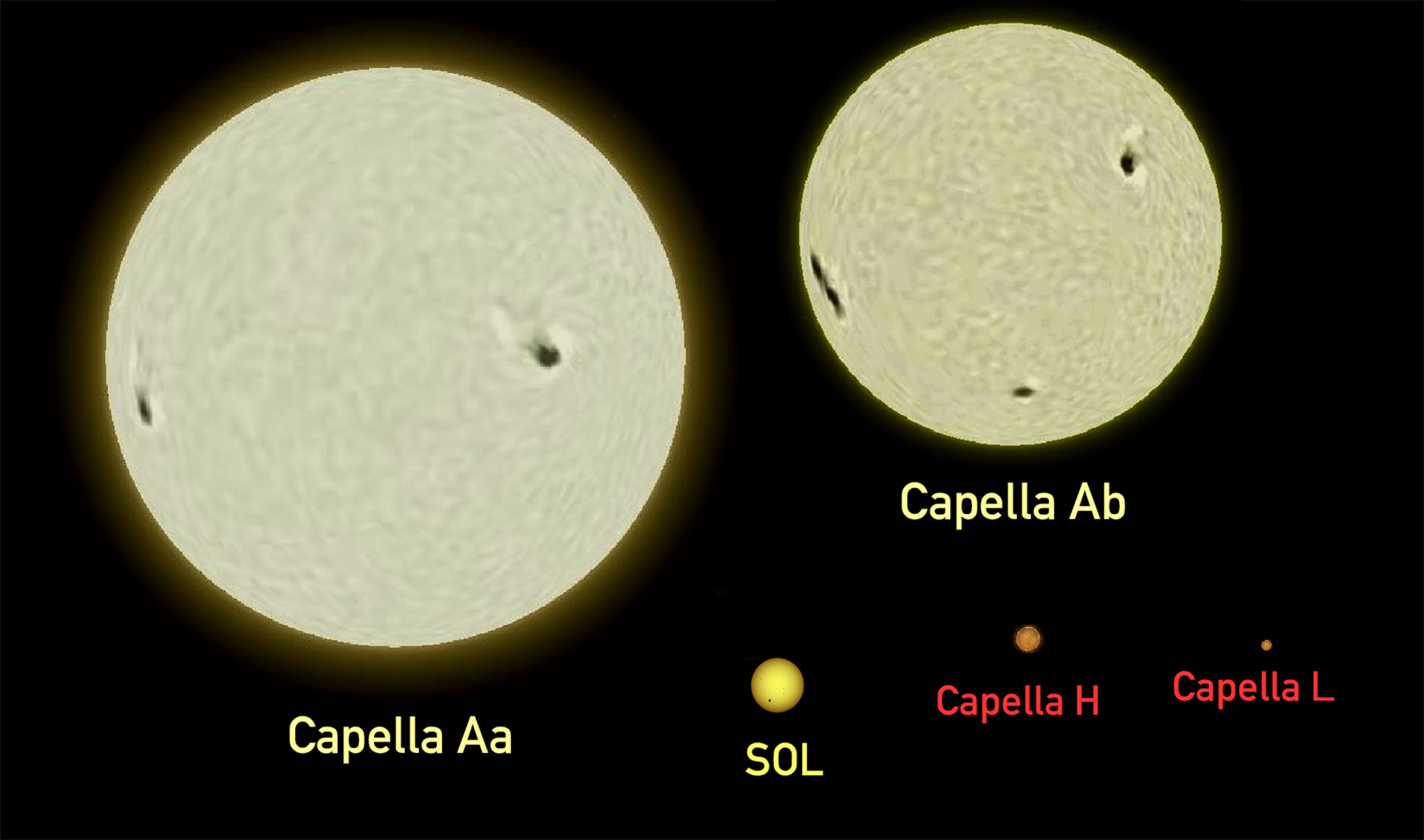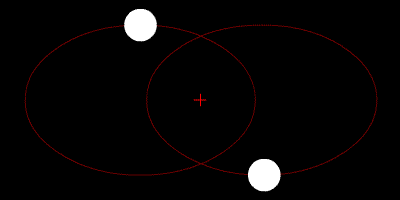|
38 Aurigae
38 Aurigae is a star located 236 light years away from the Sun in the northern constellation of Auriga. It is visible to the naked eye as a dim, orange-hued star with an apparent visual magnitude of 6.08. The star is moving further from the Earth with a heliocentric radial velocity of +34 km/s, and it has a relatively high proper motion, traversing the celestial sphere at the rate of 0.181 arc seconds per annum. It is a probable member of the Hercules stream. This object is an aging giant star with a stellar classification of K0 III. At the age of around 3.6 billion years it is a red clump giant, which indicates it is on the horizontal branch and is generating energy via helium fusion at its core. The star has 1.59 times the mass of the Sun and has expanded to 7 times the Sun's radius. It is radiating 18 times the Sun's luminosity from its swollen photosphere at an effective temperature of 4,834 K. 38 Aurigae has a faint common proper motion ... [...More Info...] [...Related Items...] OR: [Wikipedia] [Google] [Baidu] |
Auriga (constellation)
Auriga is a constellation in the northern celestial hemisphere. It is one of the List of constellations, 88 modern constellations; it was among the 48 constellations listed by the 2nd-century astronomer Ptolemy. Its name is Latin for '(the) charioteer', associating it with various mythological beings, including Erichthonius of Athens, Erichthonius and Myrtilus. Auriga is most prominent during winter evenings in the northern Hemisphere, as are five other constellations that have stars in the Winter Hexagon asterism (astronomy), asterism. Because of its northern declination, Auriga is only visible in its entirety as far south as −34°; for observers farther south it lies partially or fully below the horizon. A large constellation, with an area of 657 square degrees, it is half the size of the largest, Hydra (constellation), Hydra. Its brightest star, Capella (star), Capella, is an unusual Star system, multiple star system among the brightest stars in the night sky. Beta Aurigae ... [...More Info...] [...Related Items...] OR: [Wikipedia] [Google] [Baidu] |
Sun's Radius
Solar radius is a unit of distance used to express the size of objects in astronomy relative to the Sun. The solar radius is usually defined as the radius to the layer in the Sun's photosphere where the optical depth equals 2/3: 1\,R_ = 6.957\times 10^8 \hbox is approximately 10 times the average radius of Jupiter, 109 times the radius of the Earth, and 1/215 of an astronomical unit, the approximate distance between Earth and the Sun. The solar radius to either pole and that to the equator differ slightly due to the Sun's rotation, which induces an oblateness in the order of 10 parts per million. Measurements The uncrewed SOHO spacecraft was used to measure the radius of the Sun by timing transits of Mercury across the surface during 2003 and 2006. The result was a measured radius of . Haberreiter, Schmutz & Kosovichev (2008) determined the radius corresponding to the solar photosphere to be . This new value is consistent with helioseismic estimates; the same study showed ... [...More Info...] [...Related Items...] OR: [Wikipedia] [Google] [Baidu] |
Hipparcos Objects
''Hipparcos'' was a scientific satellite of the European Space Agency (ESA), launched in 1989 and operated until 1993. It was the first space experiment devoted to precision astrometry, the accurate measurement of the positions and distances of celestial objects on the sky. This permitted the first high-precision measurements of the luminosity, intrinsic brightnesses, proper motions, and parallaxes of stars, enabling better calculations of their distance and tangential velocity. When combined with radial velocity measurements from spectroscopy, astrophysicists were able to finally measure all six quantities needed to determine the motion of stars. The resulting ''Hipparcos Catalogue'', a high-precision catalogue of more than 118,200 stars, was published in 1997. The lower-precision ''Tycho Catalogue'' of more than a million stars was published at the same time, while the enhanced Tycho-2 Catalogue of 2.5 million stars was published in 2000. ''Hipparcos'' follow-up mission, ''Gaia ... [...More Info...] [...Related Items...] OR: [Wikipedia] [Google] [Baidu] |
Henry Draper Catalogue Objects
Henry may refer to: People and fictional characters * Henry (given name), including lists of people and fictional characters * Henry (surname) * Henry, a stage name of François-Louis Henry (1786–1855), French baritone Arts and entertainment * Henry (2011 film), ''Henry'' (2011 film), a Canadian short film * Henry (2015 film), ''Henry'' (2015 film), a virtual reality film * ''Henry: Portrait of a Serial Killer'', a 1986 American crime film * Henry (comics), ''Henry'' (comics), an American comic strip created in 1932 by Carl Anderson * "Henry", a song by New Riders of the Purple Sage Places Antarctica * Henry Bay, Wilkes Land Australia *Henry River (New South Wales) *Henry River (Western Australia) Canada * Henry Lake (Vancouver Island), British Columbia * Henry Lake (Halifax County), Nova Scotia * Henry Lake (District of Chester), Nova Scotia New Zealand * Lake Henry (New Zealand) * Henry River (New Zealand) United States * Henry, Illinois * Henry, Indiana * Henry, Nebras ... [...More Info...] [...Related Items...] OR: [Wikipedia] [Google] [Baidu] |
Flamsteed Objects
John Flamsteed (19 August 1646 – 31 December 1719) was an English astronomer and the first Astronomer Royal. His main achievements were the preparation of a 3,000-star catalogue, ''Catalogus Britannicus'', and a star atlas called '' Atlas Coelestis'', both published posthumously. He also made the first recorded observations of Uranus, although he mistakenly catalogued it as a star, and he laid the foundation stone for the Royal Greenwich Observatory. Life Flamsteed was born in Denby, Derbyshire, England, the only son of Stephen Flamsteed and his first wife, Mary Spadman. He was educated at the free school of Derby and at Derby School, in St Peter's Churchyard, Derby, near where his father carried on a malting business. At that time, most masters of the school were Puritans. Flamsteed had a solid knowledge of Latin, essential for reading the scientific literature of the day, and a love of history, leaving the school in May 1662.Birks, John L. (1999) ''John Flamsteed, ... [...More Info...] [...Related Items...] OR: [Wikipedia] [Google] [Baidu] |
Durchmusterung Objects
In astronomy, Durchmusterung or Bonner Durchmusterung (BD) is an astrometric star catalogue of the whole sky, published by the Bonn Observatory in Germany from 1859 to 1863, with an extension published in Bonn in 1886. The name comes from ('run-through examination'), a German word used for a systematic survey of objects or data. The term has sometimes been used for other astronomical surveys, including not only stars, but also the search for other celestial objects. Special tasks include celestial scanning in electromagnetic spectrum, electromagnetic wavelengths shorter or longer than visible light waves. Original catalog The Bonner Durchmusterung (abbreviated BD), was initiated by Friedrich Wilhelm Argelander, Friedrich Argelander and using observations largely carried out by his assistants, which resulted in a catalogue of the positions and apparent magnitudes of 342,198 stars down to approximate apparent magnitude 9.5 and covering the sky from 90°N to 2°S declination. The cat ... [...More Info...] [...Related Items...] OR: [Wikipedia] [Google] [Baidu] |
Auriga
Auriga is a constellation in the northern celestial hemisphere. It is one of the 88 modern constellations; it was among the 48 constellations listed by the 2nd-century astronomer Ptolemy. Its name is Latin for '(the) charioteer', associating it with various mythological beings, including Erichthonius and Myrtilus. Auriga is most prominent during winter evenings in the northern Hemisphere, as are five other constellations that have stars in the Winter Hexagon asterism. Because of its northern declination, Auriga is only visible in its entirety as far south as −34°; for observers farther south it lies partially or fully below the horizon. A large constellation, with an area of 657 square degrees, it is half the size of the largest, Hydra. Its brightest star, Capella, is an unusual multiple star system among the brightest stars in the night sky. Beta Aurigae is an interesting variable star in the constellation; Epsilon Aurigae, a nearby eclipsing binary with an unusually lon ... [...More Info...] [...Related Items...] OR: [Wikipedia] [Google] [Baidu] |
K-type Giants
K-type may refer to: *AEC K-type The AEC K-type was a type of bus chassis built by Associated Equipment Company (AEC) from 1919 until 1926, mainly for use in London by the London General Omnibus Company (LGOC). Description The K-type was an important design that ended the ..., a bus chassis * K-type star, a stellar spectral classification * K-type filter, a type of electronic filter * K-type asteroid, an unusual kind of asteroid {{disambig ... [...More Info...] [...Related Items...] OR: [Wikipedia] [Google] [Baidu] |
Red Dwarf
A red dwarf is the smallest kind of star on the main sequence. Red dwarfs are by far the most common type of fusing star in the Milky Way, at least in the neighborhood of the Sun. However, due to their low luminosity, individual red dwarfs are not easily observed. Not one star that fits the stricter definitions of a red dwarf is visible to the naked eye. Proxima Centauri, the star nearest to the Sun, is a red dwarf, as are fifty of the sixty nearest stars. According to some estimates, red dwarfs make up three-quarters of the fusing stars in the Milky Way. The coolest red dwarfs near the Sun have a surface temperature of about and the smallest have radii about 9% that of the Sun, with masses about 7.5% that of the Sun. These red dwarfs have spectral types of L0 to L2. There is some overlap with the properties of brown dwarfs, since the most massive brown dwarfs at lower metallicity can be as hot as and have late M spectral types. Definitions and usage of the term "red d ... [...More Info...] [...Related Items...] OR: [Wikipedia] [Google] [Baidu] |
Projected Separation
This glossary of astronomy is a list of definitions of terms and concepts relevant to astronomy and cosmology, their sub-disciplines, and related fields. Astronomy is concerned with the study of celestial objects and phenomena that originate outside the atmosphere of Earth. The field of astronomy features an extensive vocabulary and a significant amount of jargon. A B C D E F G H I ... [...More Info...] [...Related Items...] OR: [Wikipedia] [Google] [Baidu] |
Angular Separation
Angular distance or angular separation is the measure of the angle between the orientation of two straight lines, rays, or vectors in three-dimensional space, or the central angle subtended by the radii through two points on a sphere. When the rays are lines of sight from an observer to two points in space, it is known as the apparent distance or apparent separation. Angular distance appears in mathematics (in particular geometry and trigonometry) and all natural sciences (e.g., kinematics, astronomy, and geophysics). In the classical mechanics of rotating objects, it appears alongside angular velocity, angular acceleration, angular momentum, moment of inertia and torque. Use The term ''angular distance'' (or ''separation'') is technically synonymous with ''angle'' itself, but is meant to suggest the linear distance between objects (for instance, a pair of stars observed from Earth). Measurement Since the angular distance (or separation) is conceptually identical to an ang ... [...More Info...] [...Related Items...] OR: [Wikipedia] [Google] [Baidu] |
Common Proper Motion
This glossary of astronomy is a list of definitions of terms and concepts relevant to astronomy and cosmology, their sub-disciplines, and related fields. Astronomy is concerned with the study of astronomical object, celestial objects and phenomena that originate outside the atmosphere of Earth. The field of astronomy features an extensive vocabulary and a significant amount of jargon. A B C D E F G H ... [...More Info...] [...Related Items...] OR: [Wikipedia] [Google] [Baidu] |







